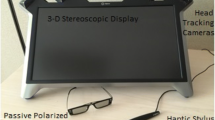Abstract
Virtual Reality (VR) is becoming an increasingly effective and powerful medium for learning, especially when applied to environments such as the International Space Station (ISS) that requires acquiring situational awareness (SA) and navigation. Research has shown, and continues to show, an encouraging array of positive learning outcomes when applying VR technology to support and improve learning. Findings include observing positive effects on spatial awareness (SA), astronaut navigation, and presence. Additionally, research has demonstrated that learners enjoy their VR experience and acknowledge the potential of VR in enhancing quality of instruction, especially regarding the immersive realism, or presence, that the virtual environment provides. It is argued that this sense of presence encourages and enhances self-paced learning and permits a more student-centered instructional approach. VR has been used in myriad fields and is not just an educational tool. But as an educational tool VR may be used to support only certain types of learning, because the medium may not work for all kinds of learning. That is because presence comprises several characteristics such as sensory effects, distraction, and realism. Also, the sense of presence may be affected by characteristics of a specific environment. To investigate this latter statement the objective of this study was to evaluate four components of presence (sensory, distraction, realism and involvement) while participants navigated through a VR-rendered ISS environment to assess sense of presence and to determine the level of presence in the virtual world of the ISS. The results indicate that when applied to these visual and kinesthetic modes of learning (the other modes being auditory and reading and writing), VR as an instructional tool is not superior to conventional learning. This result was borne out of the assessment of the comparisons between groups when completing navigation tasks and diagram tasks.














Similar content being viewed by others
References
Aoki H, Oman CM, Buckland DA, Natapoff A (2007) Desktop-VR system for preflight 3D navigation training. Acta Astronaut. https://doi.org/10.1016/j.actaastro.2007.11.001
Barnett M, Yamagatah-Lynch L, Keating T, Barab SA, Hay KE (2005) Using virtual reality computer models to support student understanding of astronomical concepts. J Comput Math Sci Teach 24(4):333–356
Crosier JK, Cobb SVG, Wilson JR (2000) Experimental comparison of virtual reality with traditional teaching methods for teaching radioactivity. Edu Inform Technol 5(4):329–343
Crumpton LL, Harden EL (1997) Using virtual reality as a tool to enhance classroom instruction. Comput Ind Eng 33(1–2):217–220
Dalgarno B, Hedberg J, Harper B (2002) The contribution of 3D environments to conceptual understanding. Paper presented at the ASCILITE 2002, Auckland, New Zealand.
Strangman, N., & Hall, T. (2003). Virtual reality/simulations. Wakefield, MA: National Center on Accessing the General Curriculum. Retrieved May 9, 2006, from http://www.cast.org/publications/ncac/ncac_vr.html Kong, S.C., Ogata, H., Arnseth, H.C., Chan,
Um, E., Song, H., & Plass, J. (2007). The effect of positive emotions on multimedia learning. In C. Montgomerie & J. Seale (Eds.), Proceedings of World Conference on Educational Multimedia, Hypermedia and Telecommunications. Chesapeake, VA: AACE.
Witmer BG, Singer MJ (1998) Measuring presence in virtual environments: a presence questionnaire. Presence Teleoper Virtual Environ 7(3):225–240
Youngblut, C. (1998). Education uses of virtual reality technology (No. IDA Document Report no. D2128): Alexandria, VA: Institute for Defense Analyses.
Acknowledgements
The author would like to thank Brian Walcutt for his contribution to the statistical analysis. The author would also like to thank the participants who took part in this study.
Funding
This work was funded by the Embry-Riddle Aeronautical University FIRST Grant 13225.
Author information
Authors and Affiliations
Corresponding author
Additional information
Publisher's Note
Springer Nature remains neutral with regard to jurisdictional claims in published maps and institutional affiliations.
Rights and permissions
About this article
Cite this article
Seedhouse, E. Presence within the virtual reality environment of the international space station. Virtual Reality 26, 1145–1153 (2022). https://doi.org/10.1007/s10055-021-00615-1
Received:
Accepted:
Published:
Issue Date:
DOI: https://doi.org/10.1007/s10055-021-00615-1




